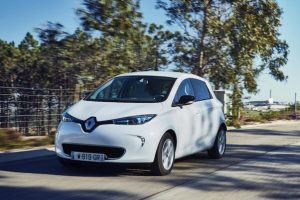In all countries, land transport (all modes) is a major emitter of greenhouse gases, mainly CO2 (but also nitrogen oxides). In France, they represented 29% of total emissions, in 2015, ie 130 MtCO2 / year (55% for private vehicles), agriculture (20%) and residential-tertiary sector (19%). As stated in an interesting report by France Strategie (see D.Auverlot, Electric Vehicle for Climate Relief, December 2016, www.francestrategie1727.fr ): « The transport sector is a prime target because its emissions have increased by almost 10% since 1990 « . Reducing and ultimately eliminating these emissions is, it is understood, an important objective of climate and energy policies. For its part, the EU has set an average new vehicle emissions goal of 95g CO2 / km (equivalent to a fuel consumption of 3.2 liters per 100km) by 2021. It is also understandable that the French Minister for Ecological and Solidarity Transition, Nicolas Hulot, wanted to set a very ambitious goal for car manufacturers by presenting the government « Climate Plan », on July 6, 2017: « We aim- he said – the end of the sale of gasoline and diesel cars by 2040 « . This objective should encourage car manufacturers to innovate and be leaders in their market, it would achieve a carbon neutrality in 2050 (ie. total energy decarbonization).
How can this ambitious goal be achieved? Replacing heat-powered vehicles with totally electric vehicles, excluding hybrid cars (with the possible exception of those that would operate with a thermal engine using « neutral » biofuels for climate) is the only way. This transition, which would have to be made in less than 25 years, represents a formidable technological, industrial and economic challenge that few countries have set themselves (Norway plans to achieve it by 2025 and Sweden by 2030,UK and China having set the same objective as France recently). In his note on Electric Vehicles, France Stratégie pointed out that the electric vehicle still represents a niche market even  if it is developing in several countries : the 100 000 registrations of new all-electric cars threshold was exceeded in Europe in 2016 (27 000 vehicles in France), but 300 000 hybrid vehicles had been marketed in the EU. The electric vehicle still suffers from two major handicaps: its purchase cost remains high (even if it benefits in France a premium of 6000 € with an additional bonus of 4000 € to replace a diesel vehicle), its battery has limited autonomy (150-400 km, depending on its weight) and is expensive, as the fast charging stations are still limited in number (15 000 in France). These technical problems are obstacles to which we shall come back (the photographe represents the electric car (« La jamais contente » which for the first time, in 1999, reached the 100km/ h threshold) .
if it is developing in several countries : the 100 000 registrations of new all-electric cars threshold was exceeded in Europe in 2016 (27 000 vehicles in France), but 300 000 hybrid vehicles had been marketed in the EU. The electric vehicle still suffers from two major handicaps: its purchase cost remains high (even if it benefits in France a premium of 6000 € with an additional bonus of 4000 € to replace a diesel vehicle), its battery has limited autonomy (150-400 km, depending on its weight) and is expensive, as the fast charging stations are still limited in number (15 000 in France). These technical problems are obstacles to which we shall come back (the photographe represents the electric car (« La jamais contente » which for the first time, in 1999, reached the 100km/ h threshold) .
Before the position of Minister Nicolas Hulot, France Strategie had envisaged, before the governmental plan, two medium-term options for private vehicles. The first one would be to build a thermal vehicle that would consume 2 liters per 100 km, by 2030. It is also a technological challenge (with higher engine temperature operation) but even coupled to an electric motor, this option does not allow total energy decarbonization (the engine would emit 50 gCO2 / km). The second option is that of the totally electric vehicle by 2050, compatible with the carbon neutrality, that retained by the French plan for 2040. The first option is no longer on the agenda after the position taken by Nicolas Hulot . France Strategie considered that the all-electric option in 2040 « would be made more credible in the eyes of car manufacturers and users if it were preceded by circulation restrictions for fossil fuel engines in the center of European cities and the gradual increase of automotive fuel taxes. The report estimates that a French fleet of 30 million all-electric vehicles would represent an annual electricity consumption of about 90 TWh, ie 20% of total consumption, which seems a priori  manageable but with a critical point that is the daily (partial or total) recharging of the batteries. A recharge at the end of the day (especially at rush hour between 18:00 and 20:00) of the whole fleet car would represent a power demand which might not be supported by the electricity grid, unless a reserve of 90 GW of production power would be secured, with probably a high cost, it would thus be necessary to spread out the loading periods outside the rush hour (at night in particular). It is true that the use of electric cars presupposes another model of mobility with small vehicles for urban and peri-urban trips (20 to 30 km per day of the type of the Renault Zoe, cf.picture), which can be satisfied with an autonomy of 150 km (an energy stored in batteries of 25 kWh) limiting thus the battery charging frequency. In any case, the all-electric option requires a network construction of nearly 30 million charging stations by 2040, an investment that according to France Strategy would represent a 15 billion euros investment (with an additional one for more expensive fast charging terminals valued at € 10-20 billion). ENEDIS, in charge of the local grid, has invested approximately € 30 billion in the infrastructures needed to integrate renewable energies into the electricity grid (production would only be used for electric mobility at 20%).
manageable but with a critical point that is the daily (partial or total) recharging of the batteries. A recharge at the end of the day (especially at rush hour between 18:00 and 20:00) of the whole fleet car would represent a power demand which might not be supported by the electricity grid, unless a reserve of 90 GW of production power would be secured, with probably a high cost, it would thus be necessary to spread out the loading periods outside the rush hour (at night in particular). It is true that the use of electric cars presupposes another model of mobility with small vehicles for urban and peri-urban trips (20 to 30 km per day of the type of the Renault Zoe, cf.picture), which can be satisfied with an autonomy of 150 km (an energy stored in batteries of 25 kWh) limiting thus the battery charging frequency. In any case, the all-electric option requires a network construction of nearly 30 million charging stations by 2040, an investment that according to France Strategy would represent a 15 billion euros investment (with an additional one for more expensive fast charging terminals valued at € 10-20 billion). ENEDIS, in charge of the local grid, has invested approximately € 30 billion in the infrastructures needed to integrate renewable energies into the electricity grid (production would only be used for electric mobility at 20%).
Electric motors are simpler to build than thermal engines (they do not operate at high temperatures) and their production is not a major technical issue for car manufacturers, but the improvement of battery performance is the real technological challenge of the electric mobility: increase their energy density (up from 150 Wh /kg with current lithium-ion batteries), reduce their production price, guarantee their durability (a large number of charge-discharge cycles without reducing their storage capacity ). We have touched on this issue a number of times. Let us recall that the solution of an electric motor operating with a hydrogen fuel cell is an alternative but that it is far from being technically and economically feasible. What is more, this option would also involve the construction of a more complicated and costly network of hydrogen service stations (on-site production by electrolysis?); it is preferable to bet on an efficient battery with charging terminals (the fuel cell remaining, meanwhile, an open option for the stationary storage of electricity).
Technically, improvement of the lithium-ion battery is possible (by modifying the electrodes, for example using silicon) but other tracks are explored: the lithium-oxygen couple (this forms an oxide with the lithium – oxygen, lithium and sodium-sulfur pairs (the latter being tested on stationary batteries). In 2015 the cost of lithium-ion battery was 250 € / kWh (about 35% of the price of a car in 2015); Elon Musk, the founder of Tesla has set the objective of lowering it by one third by 2025.
The objective of private electric vehicles production set by the French government and envisaged by other countries (in 2011, Germany set a goal of a fleet of one million electric vehicles in 2020, which appears to be out of reach), can only be achieved with incentives (subsidies, tax exemptions). N. Hulot suggested that this would be the case, new “bonuses” would be granted to purchasers of electric vehicles replacing diesel or gasoline cars. A recent study by the JRC (P. Zsussa et al., « The effect of tax incentives on market penetration of electric vehicles: Energy policy, 10 (2017), p.524, www.eceuropa.eu ) on eight European countries shows that in Norway, where tax incentives (exemption from VAT and circulation tax) and subsidies are generous (from 39 to 67% of the purchase price in the form of a subsidy), the cost of purchasing an electric vehicle is lower than that of a thermal motor one. The situation is more contrasted for other countries and depends on vehicles, on average electric and hybrid vehicles are more expensive to purchase than thermal vehicles. In France and the United Kingdom, financial aid is more favorable for small electric vehicles, which become competitive in terms of purchasing and use. This study has the merit of showing that well-balanced financial incentives favor the penetration of electric vehicles into the market but that their cost is high as shown by the example of Norway. A strong increase in the taxation of petroleum fuels at European level would also be a deterrent to the purchase of thermal vehicles.
Stopping heat engine cars commercialization in 2040 is a radical measure which, in addition to its climatic impact, would eliminate the negative externalities associated with this mode of transport (air and noise pollution) by being applied to trucks and buses, the fate of which being not fixed. This objective represents a technical, industrial and financial challenge for industry and the State. Developing competitive batteries requires significant R & D effort over at least 20 years. Constructing batteries with current lithium-ion technology will require very large industrial investments (Tesla and Panasonic are planning to invest $ 5 billion to build their battery plant in Nevada). Lastly, an estimate of the total cost of Sate incentives remains to be made (cf. note on the “analysis of the cost-benefits of electric vehicles, Les automobiles”, Commissariat Général au Développement durable, July 2017,  www.ecologique-solidaire.gouv.fr ), it will probably be important (2 million new cars/ year are sold in France), but it is true, that it might partly covered by a carbon tax. The government’s objective is very likely to be difficult to achieve by 2040. In order to break the technical-industrial obstacle of the battery, a European effort is required (see IFRI, Carole Mathieu, “The race for electric batteries” what ambition for Europe?” , July 2017, www.ifri.org ), especially as Europe is lagging behind in this area by China, the United States, Japan and South Korea, which are making a major investment effort. In the longer term, the supply of « critical » metals needed for the construction of batteries and electric motors (especially rare earths, lithium and cobalt) will arise but it is never taken into account. Political voluntarism is certainly necessary to ensure the energy transition but it cannot do without the technique.
www.ecologique-solidaire.gouv.fr ), it will probably be important (2 million new cars/ year are sold in France), but it is true, that it might partly covered by a carbon tax. The government’s objective is very likely to be difficult to achieve by 2040. In order to break the technical-industrial obstacle of the battery, a European effort is required (see IFRI, Carole Mathieu, “The race for electric batteries” what ambition for Europe?” , July 2017, www.ifri.org ), especially as Europe is lagging behind in this area by China, the United States, Japan and South Korea, which are making a major investment effort. In the longer term, the supply of « critical » metals needed for the construction of batteries and electric motors (especially rare earths, lithium and cobalt) will arise but it is never taken into account. Political voluntarism is certainly necessary to ensure the energy transition but it cannot do without the technique.
